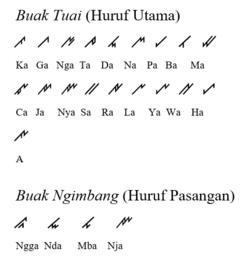
Back Rejang-Schrift German Écriture redjang French Redzsang írás Hungarian Aksara Rejang ID Scrittura rejang Italian ルジャン文字 Japanese Huruf Rejang KGE Aksara Rejang Malay Redjang (schrift) Dutch Pismo rejang Polish
This article needs additional citations for verification. (August 2018) |
| Rejang ꥆꤰ꥓ꤼꤽ ꤽꥍꤺꥏ | |
|---|---|
 | |
| Script type | |
Time period | ?–present |
| Direction | Left-to-right |
| Languages | Malay, Bengkulu, Rejang |
| Related scripts | |
Parent systems | |
Sister systems | Kerinci, Lampung, Lembak, Ogan, Pasemah, Serawai |
| ISO 15924 | |
| ISO 15924 | Rjng (363), Rejang (Redjang, Kaganga) |
| Unicode | |
Unicode alias | Rejang |
| U+A930–U+A95F | |
| Part of a series on | |
|---|---|
| |
| Writing systems used in Indonesia | |
| Brahmic scripts | |
| Arabic script | |
| Hangul script | |
| Alphabetical script | |
| Related | |
| Brahmic scripts |
|---|
| The Brahmi script and its descendants |
The Rejang script is an abugida of the Brahmic family that is related to other scripts of the region, such as the Batak and Lontara scripts. Rejang is also a member of the closely related group of Ulu scripts that include the script variants of South Sumatra, Bengkulu, Lembak, Lintang, Lebong, and Serawai. Other closely related scripts that are sometimes included in the Surat Ulu group include the Ogan, Kerinci, and Lampung scripts. The script was in use prior to the introduction of Islam to the Rejang area; the earliest attested document appears to date from the mid-18th century CE. The Rejang script is sometimes also known as the KaGaNga script following the first three letters of the alphabet. The term KaGaNga was never used by the users of the script community, but it was coined by the British anthropologist Mervyn A. Jaspan (1926–1975) in his book Folk literature of South Sumatra. Redjang Ka-Ga-Nga texts. Canberra, The Australian National University 1964.
The script was used to write texts in Malay and Rejang, which is now spoken by about 200,000 people living in Indonesia on the island of Sumatra in the southwest highlands, north Bengkulu Province, around Arga Makmur, Muaraaman, Curup, and Kepahiang, and also in the Rawas area of South Sumatra Province, near Muara Kulam. There are five major dialects of Rejang: Lebong, Musi, Kebanagung, Pesisir (all in Bengkulu Province), and Rawas (in South Sumatra Province). Most of its users live in fairly remote rural areas, of whom slightly less than half are literate.
The traditional Rejang corpus consists chiefly of ritual texts, medical incantations, and poetry.
